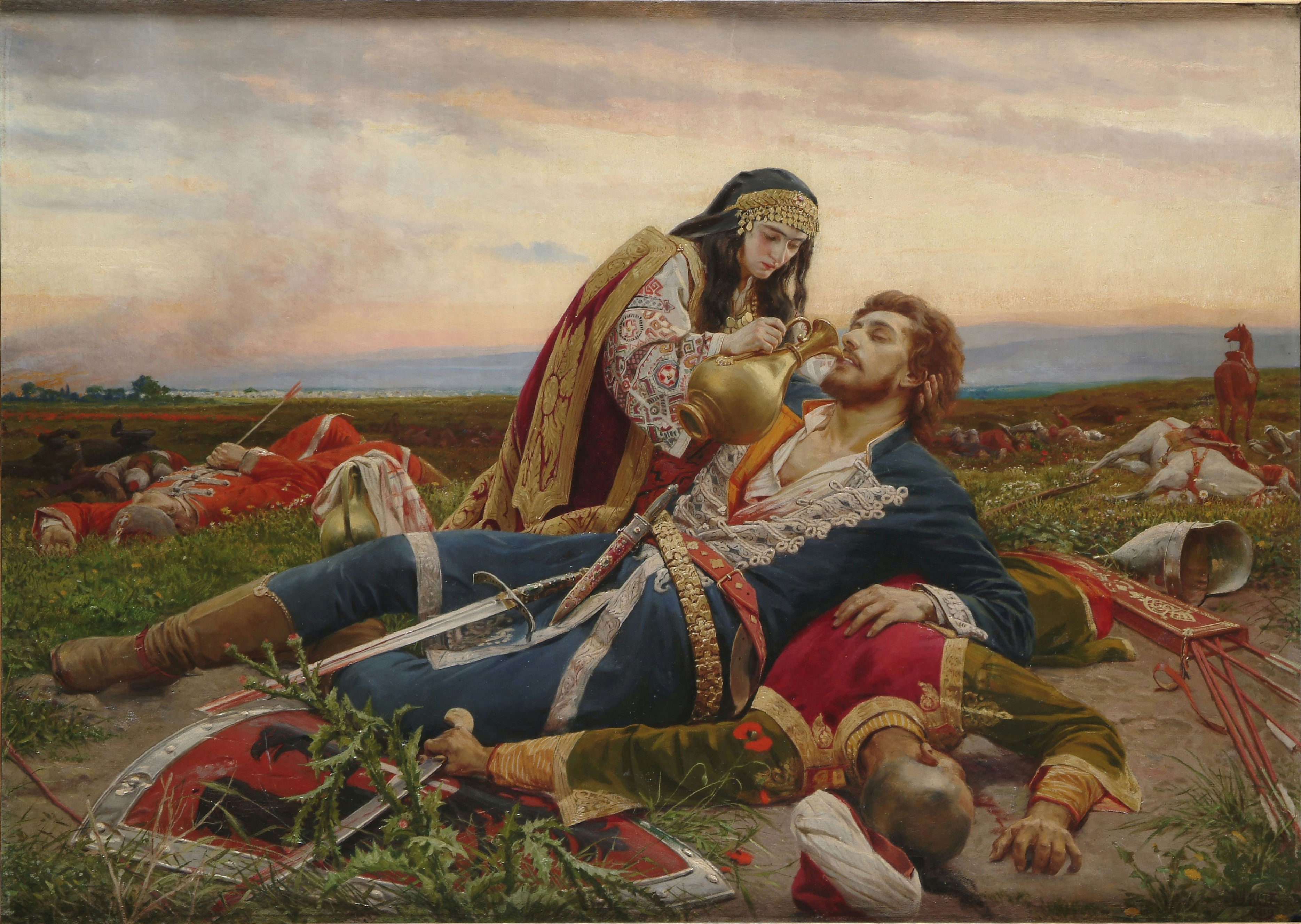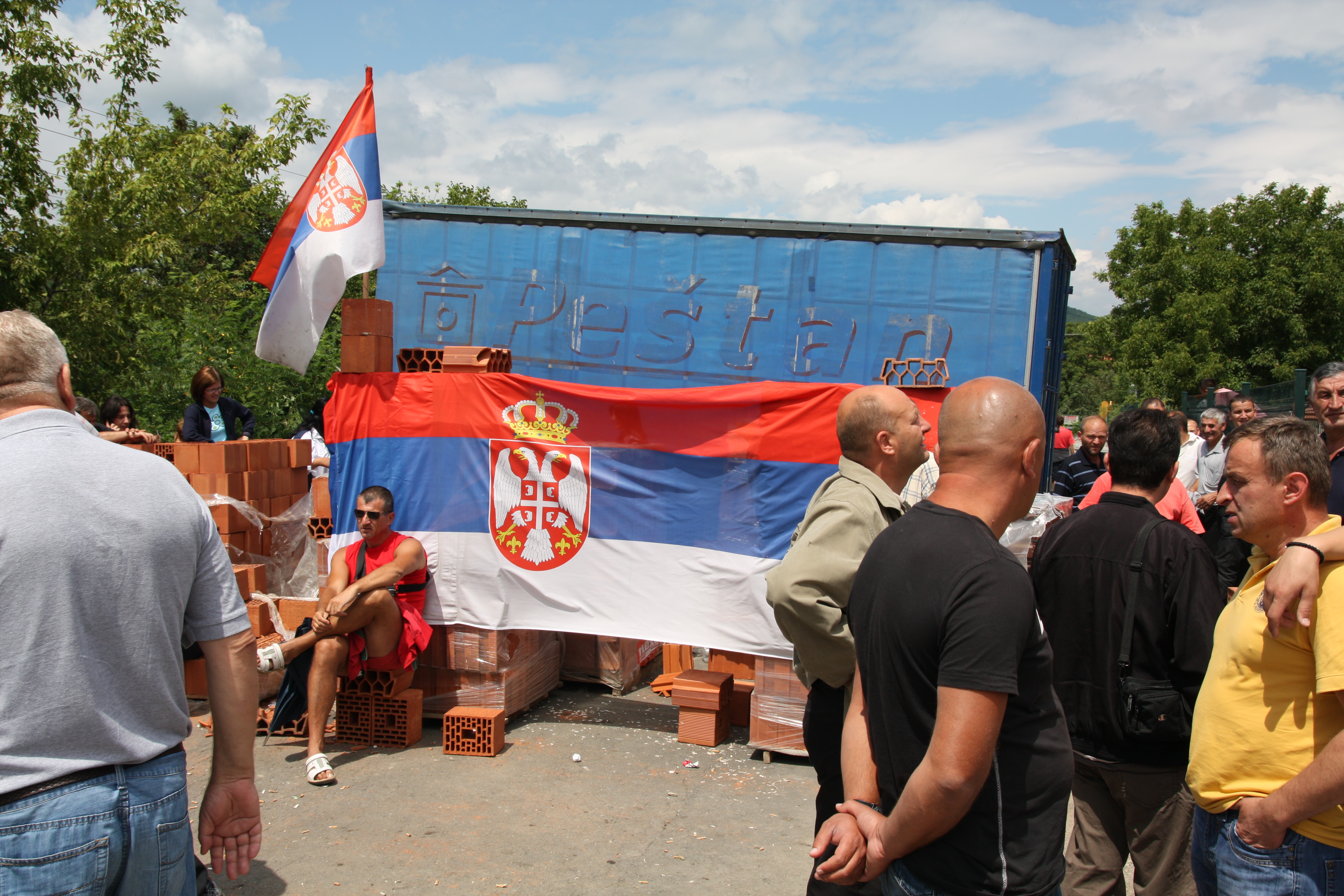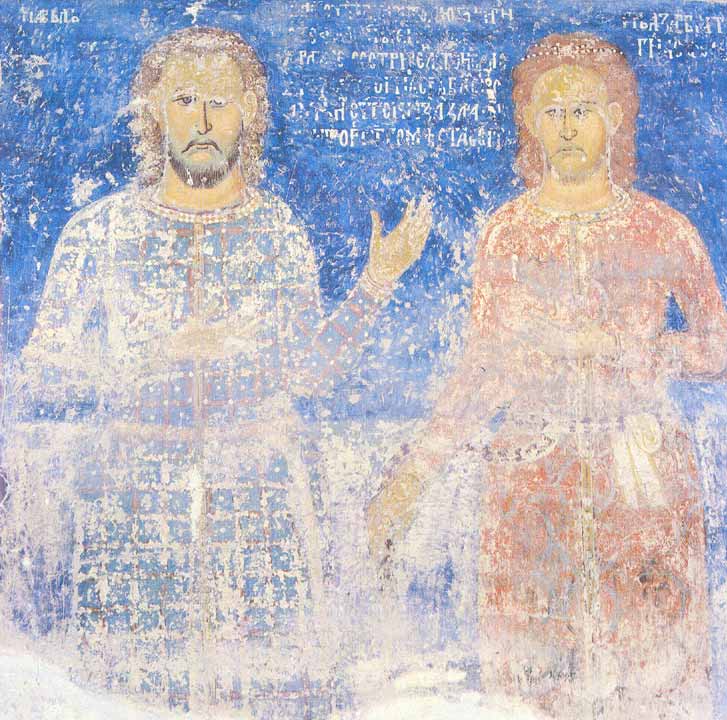|
Stevo Vasojević
Stevo Vasojević or Vasojević Stevo ( sr-cyr, Васојевић Стево), is a character in the Kosovo Cycle of Serbian epic poetry and a legendary ancestor of the Vasojevići tribe, the largest tribe in the Montenegrin Highlands. According to the epics (such as ''Pogibija Pavla Orlovića i Steva Vasojevića na Kosovu''), he was a nobleman who fought and died at the Battle of Kosovo (1389). It is known that Stefan Konstantin had a son, Stefan Vasoje (or Vaso), and it is claimed that he was the father of Stevo Vasojević. According to the story the Vasojevići are descendants of a Vaso (the eponymous founder), who was born in Prizren and served as a ''vojvoda'' (general) during the reign of Emperor Stefan Dušan (r. 1331–1355). His son, Vasojević Stevo, was a Vojvoda in Sjenica, with his court in the Dubnica village. Legends from the Montenegrin Highlands have it that Stevo was a Best man on the wedding of Miloš Obilić, a famed Serbian knight who slaughtered Sultan Murad ... [...More Info...] [...Related Items...] OR: [Wikipedia] [Google] [Baidu] |
Serbian Epic Poetry
Serbian epic poetry ( sr, Српске епске народне песме, Srpske epske narodne pesme) is a form of epic poetry created by Serbs originating in today's Serbia, Bosnia and Herzegovina, Croatia, Montenegro and North Macedonia. The main cycles were composed by unknown Serb authors between the 14th and 19th centuries. They are largely concerned with historical events and personages. The instrument accompanying the epic poetry is the ''gusle''. Serbian epic poetry helped in developing the Serbian national identity, Serbian national consciousness. The cycles of Prince Marko, the Hajduks and Uskoks inspired the Serbs to restore freedom and their heroic past. The Hajduks in particular, are seen as an integral part of national identity; in stories, the hajduks were heroes: they had played the role of the Serbian elite during Ottoman rule, they had defended the Serbs against Ottoman oppression, and prepared for the national liberation and contributed to it in the Serbian R ... [...More Info...] [...Related Items...] OR: [Wikipedia] [Google] [Baidu] |
Kosovo Curse
The Kosovo curse ( sr, Косовска клетва / ''Kosovska kletva'') or Prince's curse ( sr, Кнежева клетва, link=no / ''Kneževa kletva''), is according to legend, a curse said by Serbian Prince Lazar before the Battle of Kosovo. Lazar curses those Serbs who ignored his call for war against the Ottoman Empire. Constantine of Kostenets recorded that Lazar issued "invitation and threat" to Serbian states which is preserved in the Serbian epic poetry in the form of the curse. From 1778 to 1781, Avram Miletić composed a miscellany of 129 songs ( sr, Песмарица/Pesmarica) which also included the song "A history of Musić Stefan" containing a form of the Kosovo curse. One form of the curse appeared in the 1845 edition of the collection of Serbian folk songs by Vuk Karadžić. It is an updated version of an 1813 text by Karadžić with stronger nationalist overtones. Karadžić's "Kosovo curse" is inscribed on the Gazimestan monument, where the Battle of Kos ... [...More Info...] [...Related Items...] OR: [Wikipedia] [Google] [Baidu] |
Serbian Folklore
Serbian folklore is the folk traditions among ethnic Serbs. The earliest examples of Serbian folklore are seen in the pre-Christian Slavic customs transformed into Christianity. Roots and characteristics Folklore The Apostles of the Slavs, Cyril and Methodius, have been venerated by Serbian Orthodox Christians since their Christianization in 867, they have been considered Serbs by historians. In Krajište and Vlasina there are epic stories of the extermination of Roman males in a battle, and of the settling of Russians ( Antes) Serbian Epic poetry Serbian epic poetry is a form of epic poetry written by Serbs originating in today's Serbia, Bosnia and Herzegovina and Montenegro. The main cycles were composed by unknown Serb authors between the 14th and 19th centuries. They are largely concerned with historical events and personages. The corpus of Serbian epic poetry is divided into cycles: *Non-historic cycle *Pre-Kosovo cycle - poems about events that predate the Battle of ... [...More Info...] [...Related Items...] OR: [Wikipedia] [Google] [Baidu] |
Serbian Knights
Serbian may refer to: * someone or something related to Serbia, a country in Southeastern Europe * someone or something related to the Serbs, a South Slavic people * Serbian language * Serbian names See also * * * Old Serbian (other) * Serbians * Serbia (other) * Names of the Serbs and Serbia Names of the Serbs and Serbia are terms and other designations referring to general terminology and nomenclature on the Serbs ( sr, Срби, Srbi, ) and Serbia ( sr, Србија/Srbija, ). Throughout history, various endonyms and exonyms have bee ... {{Disambiguation Language and nationality disambiguation pages ... [...More Info...] [...Related Items...] OR: [Wikipedia] [Google] [Baidu] |
Characters In Serbian Epic Poetry
Character or Characters may refer to: Arts, entertainment, and media Literature * ''Character'' (novel), a 1936 Dutch novel by Ferdinand Bordewijk * ''Characters'' (Theophrastus), a classical Greek set of character sketches attributed to Theophrastus Music * ''Characters'' (John Abercrombie album), 1977 * ''Character'' (Dark Tranquillity album), 2005 * ''Character'' (Julia Kent album), 2013 * ''Character'' (Rachael Sage album), 2020 * ''Characters'' (Stevie Wonder album), 1987 Types of entity * Character (arts), an agent within a work of art, including literature, drama, cinema, opera, etc. * Character sketch or character, a literary description of a character type * Game character (other), various types of characters in a video game or role playing game ** Player character, as above but who is controlled or whose actions are directly chosen by a player ** Non-player character, as above but not player-controlled, frequently abbreviated as NPC Other uses in ar ... [...More Info...] [...Related Items...] OR: [Wikipedia] [Google] [Baidu] |
1389 Deaths
Year 1389 ( MCCCLXXXIX) was a common year starting on Friday (link will display full calendar) of the Julian calendar. Events January–December * February 24 – Queen Margaret of Norway and Denmark defeats Albert, King of Sweden in battle and becomes ruler of all three kingdoms. Albert is deposed from the Swedish throne and taken prisoner. * May 3 – Richard II takes control of England, away from the Lords Appellant. * May 19 – Vasili I becomes Grand Prince of Moscow after the death of his father, Dmitry Donskoy. * June – The Käpplinge murders take place in Stockholm in Sweden. * June 15 – Battle of Kosovo: The Ottoman Empire and the Serbs fight an inconclusive battle with both sides suffering heavy losses. Both Sultan Murad I and Serbian Prince Lazar are killed in the battle. **Bayezid I (1389–1402) succeeds his father Murad I ( 1362–1389), as Ottoman Sultan. ** Stefan III succeeds his father, as ruler of Serbia. * July 18 – ... [...More Info...] [...Related Items...] OR: [Wikipedia] [Google] [Baidu] |
Year Of Birth Missing
A year or annus is the orbital period of a planetary body, for example, the Earth, moving in its orbit around the Sun. Due to the Earth's axial tilt, the course of a year sees the passing of the seasons, marked by change in weather, the hours of daylight, and, consequently, vegetation and soil fertility. In temperate and subpolar regions around the planet, four seasons are generally recognized: spring, summer, autumn and winter. In tropical and subtropical regions, several geographical sectors do not present defined seasons; but in the seasonal tropics, the annual wet and dry seasons are recognized and tracked. A calendar year is an approximation of the number of days of the Earth's orbital period, as counted in a given calendar. The Gregorian calendar, or modern calendar, presents its calendar year to be either a common year of 365 days or a leap year of 366 days, as do the Julian calendars. For the Gregorian calendar, the average length of the calendar year (the mea ... [...More Info...] [...Related Items...] OR: [Wikipedia] [Google] [Baidu] |
14th-century Serbian Nobility
As a means of recording the passage of time, the 14th century was a century lasting from 1 January 1301 ( MCCCI), to 31 December 1400 ( MCD). It is estimated that the century witnessed the death of more than 45 million lives from political and natural disasters in both Europe and the Mongol Empire. West Africa experienced economic growth and prosperity. In Europe, the Black Death claimed 25 million lives wiping out one third of the European population while the Kingdom of England and the Kingdom of France fought in the protracted Hundred Years' War after the death of Charles IV, King of France led to a claim to the French throne by Edward III, King of England. This period is considered the height of chivalry and marks the beginning of strong separate identities for both England and France as well as the foundation of the Italian Renaissance and Ottoman Empire. In Asia, Tamerlane (Timur), established the Timurid Empire, history's third largest empire to have been ever establis ... [...More Info...] [...Related Items...] OR: [Wikipedia] [Google] [Baidu] |
North Kosovo
North Kosovo ( sr, Северно Косово, Severno Kosovo; sq, Kosova Veriore), also known as the Ibar Kolašin ( sr, Ибарски Колашин, Ibarski Kolašin; sq, Koloshini i Ibrit or ''Kollashini i Ibrit''; earlier ''Old Kolašin'', sr, Стари Колашин, Stari Kolašin; sq, Koloshini i Vjetër or ''Kollashini i Vjetër''), is a region in the northern part of Kosovo, generally understood as a group of four municipalities with ethnic Kosovo Serbs majority: North Mitrovica, Leposavić, Zvečan and Zubin Potok. Prior to the 2013 Brussels Agreement, the region functioned independently from the institutions in Kosovo, as they refused to acknowledge and recognize the independence of Kosovo, declared in 2008. The Government of Kosovo opposed any kind of parallel government for Serbs in this region. However, the parallel structures were all abolished by the Brussels Agreement, signed between the governments of Kosovo and Serbia. Both governments agreed upon ... [...More Info...] [...Related Items...] OR: [Wikipedia] [Google] [Baidu] |
Prince Lazar
Lazar Hrebeljanović ( sr-cyr, Лазар Хребељановић; ca. 1329 – 15 June 1389) was a medieval List of Serbian monarchs, Serbian ruler who created the largest and most powerful state on the territory of the disintegrated Serbian Empire. Lazar's state, referred to by historians as Moravian Serbia, comprised the basins of the Great Morava, West Morava, and South Morava rivers. Lazar ruled Moravian Serbia from 1373 until his death in 1389. He sought to resurrect the Serbian Empire and place himself at its helm, claiming to be the direct successor of the Nemanjić dynasty, which went extinct in 1371 after ruling over Serbia for two centuries. Lazar's programme had the full support of the Serbian Orthodox Church, but the Serbian nobility did not recognize him as their supreme ruler. He is often referred to as Tsar Lazar Hrebeljanović ( sr, Цар Лазар Хребељановић / ''Car Lazar Hrebeljanović''); however, he only held the title of prince ( sr, link= ... [...More Info...] [...Related Items...] OR: [Wikipedia] [Google] [Baidu] |
Musić Noble Family
The Musić ( sr-cyr, Мусић, Musići / Мусићи) was a Serbian noble house that served the Serbian Empire (1345–1371), and during its fall (1371–1389) it served Tsar Lazar's Serbia. The eponymous founder was ''čelnik'' Musa, who married Dragana Hrebeljanović, the sister of Tsar Lazar (r. 1371-1389). Stefan and Lazar Musić, the sons of Musa, held a region of roughly modern Raška municipality and north Kosovo. The brothers died fighting the Ottoman Empire in the Battle of Kosovo (1389). History They held a region of north Kosovo, around Ibar with the seat in Zvečan. Musa was given the estate by Emperor Stefan Uroš V (r. 1355-1371). They relocated their seat to Brvenik on the Ibar, due to the swapping of fortified cities with Vojislav Vojinović (around 1355-1363). Their province included the Kopaonik area (with mines), in the middle of the Ibar and Lab, and stretched from the Radočelo and Brvenička župa in the northwest, to the Brvenica tributary ... [...More Info...] [...Related Items...] OR: [Wikipedia] [Google] [Baidu] |
Ottoman Empire
The Ottoman Empire, * ; is an archaic version. The definite article forms and were synonymous * and el, Оθωμανική Αυτοκρατορία, Othōmanikē Avtokratoria, label=none * info page on book at Martin Luther University) // CITED: p. 36 (PDF p. 38/338) also known as the Turkish Empire, was an empire that controlled much of Southeast Europe, Western Asia, and Northern Africa between the 14th and early 20th centuries. It was founded at the end of the 13th century in northwestern Anatolia in the town of Söğüt (modern-day Bilecik Province) by the Turkoman tribal leader Osman I. After 1354, the Ottomans crossed into Europe and, with the conquest of the Balkans, the Ottoman beylik was transformed into a transcontinental empire. The Ottomans ended the Byzantine Empire with the conquest of Constantinople in 1453 by Mehmed the Conqueror. Under the reign of Suleiman the Magnificent, the Ottoman Empire marked the peak of its power and prosperity, as well a ... [...More Info...] [...Related Items...] OR: [Wikipedia] [Google] [Baidu] |




